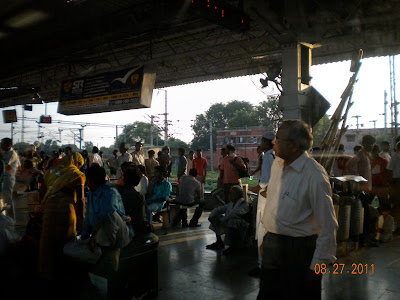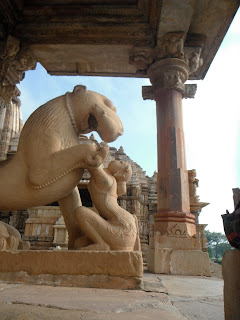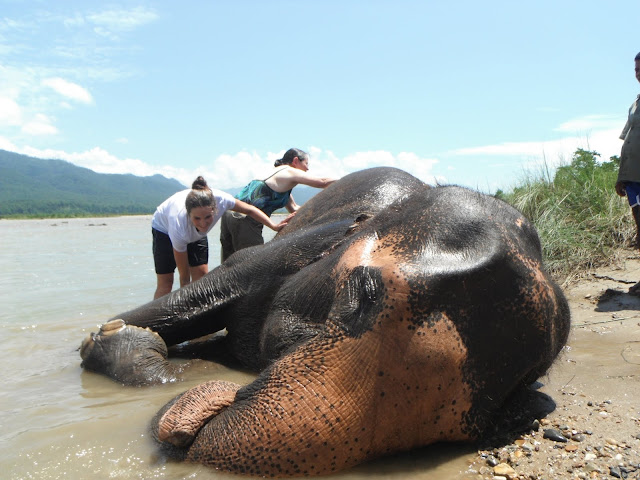 |
| Women applying make-up and nail polish, one of many scenes of daily life carved onto the temples at Khajuraho |
We drove off to the airport again, a thirty minute drive that was marked by the passing of cars driving back to Varanasi's with yellow bundles strapped to the car roof . These bundles were bodies that family members were taking to the river Ganges to cremate. Your are lucky if you die within driving distance to the river: it's straight to paradise with out another reincarnation.
The flight to Khajuraho was only 20 minutes but we share the security line with the model Heidi Klum and her husband Seal (the singer), they were headed back to Delhi after renewing their wedding vows.
Although we have not complained about humidity, we should, at this point, mention it has been at 100% and one's shirt is continually wet. This is because we are traveling with the monsoon.
In the afternoon we met with our guide who was to take us through the group of temples at Khajuraho. I think calling him an art history teacher would have been a more appropriate title. He got us in front of the first temple, one known for it's rather erotic carving and gave us a lecture on the intricacies of Hindu iconology. We would have sat longer in the soporific, hot, dripping sun if the monsoon had not saved us by pouring forth from the heavens. It rained and rained until the site closed. Somehow the rain shifted the conversation to the political situation at hand and we waded back to the car through, at times, knee deep water.
 |
| Little boy riding his bike home from school through flooded monsoon drenched streets! |

The next morning we got up and met our art history teacher who went into guide mode and saw the temples. They had been lost for centuries in the jungle but were rediscovered by a British cavalryman. The city had been the religious capital of the local dynasty separated from political headquarters by 50km. This, our guide told us was the very first enforcement of the concept of separation of church and state. The temples, which some of you may recognize from Gardener's History of Art, are covered in intricate carvings in red sandstone with scenes of daily life, angry gods and a variety of mischievous elephants.
 |
| Family photo in front of Vishvanatha Temple at Khajuraho |


The drive to Orchha was only 130 k but took 4 hours because we were traveling on typical country road shared with water buffalo, goats, cows, motorcycles and ox carts not to mention many potholes. It was an adventures and the scenes of rural India were as memorable as any of the World Heritage sight we have seen. Water buffalo are everywhere, submerged by the road in water wallows or being herded along it for milking. Buffalo give more milk than cows and are far hardier. Small children were being lead into covered wagon like bicycle rickshaws with their back packs hanging out the back. Goat herders sat in the fields under the big black umbrellas, used for both rain and sun.
 We stop along the way and had fresh roti, a bread cooked on stone and in the fire. The chef invited us into her two room stick house with a dirt floor to show us how to prepare it. Sam I have plans for a clay oven in the back yard, good for roti as well as pizza. No drive would be complete with out a stop to photograph flying foxes hagging from a road side tree.
We stop along the way and had fresh roti, a bread cooked on stone and in the fire. The chef invited us into her two room stick house with a dirt floor to show us how to prepare it. Sam I have plans for a clay oven in the back yard, good for roti as well as pizza. No drive would be complete with out a stop to photograph flying foxes hagging from a road side tree. |
| Flying foxes in a tree |
 |
| Fox taking flight |
 |
| Rickshaw schoolbus |

Orcha was our first palace. It sat on the banks of a river and provided our first notion of the magnitude of the forts in the area and the power of the people who lived there because of the sheer size. Our guide described the life that took place in these ruins and all of a sudden the stories of Mongols and Shahs and kings took shape. What was perhaps most remarkable was that the palace at Orcha was just a visiting palace. A rest stop on the way north to Agra or Sikri. Still, it was imposing, with delicately carved stone jalis contrasting starkly with thick ramparts. The entrance gate had three massive steps alongside a more normal size staircase. The lowest step was for military men to dismount from horseback. The second step was for ministers to step down from their camels. The third and highest step was for the Raj (king) to dismount his elephant and walk through the massive palace gates where he would be showered with flower petals and accompanied with music.

That evening, following the path of the Rajas we took a train to Agra. Taking a train in India is part of seeing the country. We were met by a porter who took our 40 pound bags and hoisted them up on top of his head. After perching two suitcases on top of his headscarf he proceeded to hang two more on his arms. Then without so much as a grunt he walked the 500 yards to the train platform. The atmosphere at the station was somewhat like walking into Arco for a Kings game circa 1995. The mood was generally upbeat but the sheer mass of people all trying to get to their designated section of the platform created a kind of overwhelming pandemonium. As we walked through the station we could see the trains looking like centipedes as all of the passengers in the economy class cabins stuck hundreds of arms out of narrow windows on the sides of the train cars. They were packed closely together and I doubt the train was air conditioned. On our platform, several hundred more people sat squatting on the concrete with there feet flat and their hips tucked underneath them right between their legs. This is how everyone in India sits when they are waiting for someone. Their balance and flexibility is amazing but must come from a lifetime of sitting this way. In fact even in the court scenes we saw later in palaces the ministers of the kings cabinet sat on the floor and in the many rooms and audience halls furniture was replaced by carpets and cushions.

The hubbub of the platform contrasted radically with the calm, air-conditioned cabin in which we found our seats. The porters loaded our luggage and a food trolley came down the aisle with sandwiches and tea and buttons with smiley faces on them.
More Photos!
 |
| A platform in the courtyard of Orchha palace where dancing girls performed for the Raja and special guests |
 |
| Makeshift tandoor oven for making naan, outside Orchaa palace |



































